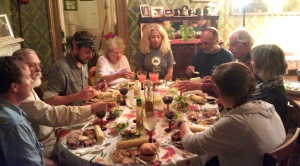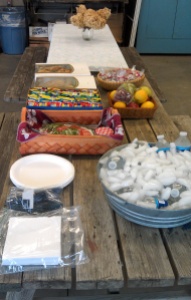by Carolyn Kennedy
Monday, August 17th, the crew of the Lois McClure was greeted at the dock of Lock 15 in Fort Plain, NY by a welcoming committee including members of the Friends of Fort Plain group. The ‘Friends’ invited us to a wine and cheese at the fire house, followed by a dinner at the Methodist church across the street. Lois’ crew and the ‘Friends’ spread out over three tables and were able to swap history and stories all night, and the crew was happy to hear a lot of the history of Fort Plain and its people.
Tuesday morning, our original plan was to host school groups from 8:30am until 2pm, but bad weather warnings encouraged us to postpone them until the following morning, and so the crew was gifted with the morning off. Despite the bad weather, some of us merited from a guided car tour of Fort Plain, hosted by Dave Manclow, one of our gracious hosts. Dave took us all through the town, pointing out some of the town’s historic houses and their residents. The real treat of that tour, at least for us canal boaters, was to visit the old Erie Canal site that runs just North of Canal Street. We could see the walls of the old canal still intact in some places, and even more impressively we were able to check out the old Lock 32, a lock in the same place as our Lock 15. The location of the lock named that part of town ‘Lockville’.
The old lock provided another point of interest to the archaeologist in me as it was located just East of the aqueduct, part of which was still visible. Long stone slabs that made up the old structure still ran through Otsquago Creek, which was a nice continuation from the old aqueduct that we discovered in Frankfort. The aqueduct in Frankfort was discovered by Art and Kerry after much debating over what some huge planks of very well-preserved wood would have been. When I visited that aqueduct later with Tom and Ian, it was the first sight of any aqueduct remains I had ever seen. Having seen that one, I quickly recognized the foundation of the aqueduct in Fort Plain at the bottom of Otsquago Creek.

At the end of our tour, Dave brought us to 47 Main St., a building that the Friends of Fort Plain were restoring to become the historic center of Fort Plain. Though still a work in progress, some of the old images stored in the building were particularly of interest to us. Specifically, one of the images showed the lift bridge over lock 32 from the 1800s, and even more exciting was an old drawing of the old Erie Canal with – you guessed it – Canal Boats! Two boats being towed through the canal by what must have been a steam tug. I was excited to see this old drawing in the town, a convincing argument that these boats really did exist and thrive in towns along the Erie Canal.

We returned in time to greet the public between 3 and 6pm that afternoon, after which we were once again invited to dinner, this time by Sevim Acar Morawski. Dave Manclow and Fred Chambers were kind enough to provide lifts for the crew to Sevim’s house. Upon arriving, our gracious host welcomed all of the crew into her fascinating home, where we were lucky enough to taste some excellent Turkish cooking. It was one of those few and far between experiences where the crew was actually able to sit around a table together and share stories. Luckily Sevim had some great stories of her immigration to the US from Turkey, since most of the crew was too occupied with eating to come up with our own stories. One of those stories was a really great mystery involving the house she and her husband purchased. Rumor had it that the man who built the house was a very successful man in the real estate business, but did not believe in keeping his money in the bank. When the man died of an accident involving him slipping and falling on his head, his children searched the entire house for the money that they were convinced must have been hidden somewhere in the superstructure. They never found the money, and each time the house was sold after that it would be searched for hidden treasure. When Sevim and her husband bought the house, they redid the entire building (having planned on it anyway) knowing full well the rumor of the hidden money. They found a box, hidden in the attic, full of paper of some kind. Unfortunately the paper had been stored for so long that it had practically turned to dust.

The generosity we received from the people of Fort Plain seemed endless. Roger and Kathleen were welcomed to stay at Melissa Brown’s B&B in town during their day off, and the rest of us were treated to breakfast and lunch by the Friends of Fort Plain. The school groups we had on Wednesday were greeted by Erick as he arranged them into a human canal system demonstrating how the canals joined Lake Champlain to the Hudson River, the Great Lakes and Canada. The kids were very well behaved, and had great questions for the crew. We were very happy to have them, and the public the day before.
Special Thanks to:
Carolyn Kennedy
A recent graduate of Concordia University in Montreal where she studied archaeology, Carolyn was introduced to the Lois McClure project while doing a nautical archaeology field school at LCMM.

Pingback: Captain’s Log, Part 7 | Lake Champlain Maritime Museum